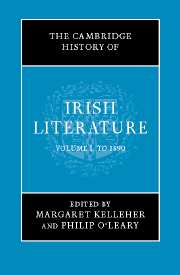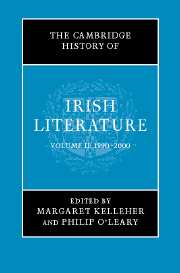11 results

The Cambridge History of Irish Literature
-
- Published online:
- 28 March 2008
- Print publication:
- 02 March 2006

The Cambridge History of Irish Literature
-
- Published online:
- 28 March 2008
- Print publication:
- 02 March 2006
Frontmatter
-
- Book:
- The Cambridge History of Irish Literature
- Published online:
- 28 March 2008
- Print publication:
- 02 March 2006, pp i-xxii
-
- Chapter
- Export citation
Index
-
- Book:
- The Cambridge History of Irish Literature
- Published online:
- 28 March 2008
- Print publication:
- 02 March 2006, pp 683-723
-
- Chapter
- Export citation
Introduction
-
-
- Book:
- The Cambridge History of Irish Literature
- Published online:
- 28 March 2008
- Print publication:
- 02 March 2006, pp 1-8
-
- Chapter
- Export citation
Guide to major subject areas
-
- Book:
- The Cambridge History of Irish Literature
- Published online:
- 28 March 2008
- Print publication:
- 02 March 2006, pp 677-682
-
- Chapter
- Export citation
Introduction
-
-
- Book:
- The Cambridge History of Irish Literature
- Published online:
- 28 March 2008
- Print publication:
- 02 March 2006, pp 1-8
-
- Chapter
- Export citation
Index
-
- Book:
- The Cambridge History of Irish Literature
- Published online:
- 28 March 2008
- Print publication:
- 02 March 2006, pp 648-682
-
- Chapter
- Export citation
Frontmatter
-
- Book:
- The Cambridge History of Irish Literature
- Published online:
- 28 March 2008
- Print publication:
- 02 March 2006, pp i-xxii
-
- Chapter
- Export citation
5 - The Irish Renaissance, 1880–1940: literature in Irish
-
-
- Book:
- The Cambridge History of Irish Literature
- Published online:
- 28 March 2008
- Print publication:
- 02 March 2006, pp 226-269
-
- Chapter
- Export citation
Guide to major subject areas
-
- Book:
- The Cambridge History of Irish Literature
- Published online:
- 28 March 2008
- Print publication:
- 02 March 2006, pp 643-647
-
- Chapter
- Export citation

